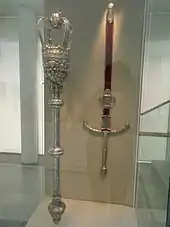Ceremonial mace
A ceremonial mace is a highly ornamented staff of metal or wood, carried before a sovereign or other high officials in civic ceremonies by a mace-bearer, intended to represent the official's authority. The mace, as used today, derives from the original mace used as a weapon. Processions often feature maces, as on parliamentary or formal academic occasions.

History
Ancient Near East
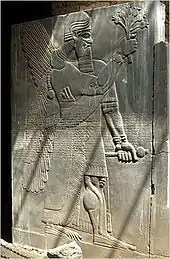
Ceremonial maces originated in the Ancient Near East, where they were used as symbols of rank and authority across the region during the late Stone Age, Bronze Age, and early Iron Age. Among the oldest known ceremonial maceheads are the Ancient Egyptian Scorpion Macehead and Narmer Macehead; both are elaborately engraved with royal scenes, although their precise role and symbolism is obscure. In later Mesopotamian art, the mace is more clearly associated with authority; by the Old Babylonian period the most common figure on cylinder seals (a type of seal used to authenticate clay documents) is a repeated type now known as "The Figure with Mace" who wears a royal hat, holds a mace in his left hand, and is thought to represent a generic king.[1] Ceremonial maces are also prominently depicted in the royal art of Ancient Assyria, such as the Stela of Ashurnasirpal II and the Stela of Shamshi-Adad V, in which the Assyrian kings are shown performing rites or making religious gestures while holding a mace to symbolise their authority.[2]
Eastern Roman Empire
Some officials of the medieval Eastern Roman Empire carried maces for either practical or ceremonial purposes. Notable among the latter is the protoallagator, a military-judicial position that existed by about the 10th century A.D. and whose symbols of office were reported by the Palaiologan writer Pseudo-Kodinos in the 14th century to include a silver-gilt mace (matzouka). At this time the duties of the protoallagator included commanding the emperor's personal allagion, his military retinue. The ceremonial function of the mace may have passed to the late Roman Empire from the ancient Near East by way of Persia,[3] and from there to other European cultures.[4]
Medieval and Renaissance Europe
The earliest ceremonial maces in France and England were practical weapons intended to protect the king's person, borne by the Sergeants-at-Arms, a royal bodyguard established in France by Philip II, and in England probably by Richard I, (c. 1180). By the 14th century, these sergeants' maces had started to become increasingly decorative, encased in precious metals. As a weapon, the mace fell out of use with the disappearance of heavy armour.
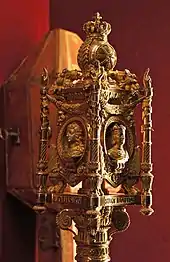
The history of the civic mace (carried by the sergeants-at-arms) begins around the middle of the 13th century, though no examples from that period remain today. The oldest civic mace in England (still remaining today) is that of Hedon. It was granted (along with an important charter) in 1415.[5] At the time, ornamented civic maces were considered an infringement of one of the privileges of the king's sergeants, who alone deserved to bear maces enriched with costly metals, according to a House of Commons petition of 1344. However, the sergeants of London later gained this privilege, as did later those of York (1396), Norwich (1403–1404), and Chester (1506). Records exist of maces covered with silver in use at Exeter in 1387–1388; Norwich bought two in 1435, and Launceston others in 1467 and 1468. Several other cities and towns subsequently acquired silver maces, and the 16th century saw almost universal use.
Early in the 15th century, the flanged end of the mace (the head of the war mace) was carried uppermost, with the small button bearing the royal arms in the base. By the beginning of the Tudor period, however, the blade-like flanges, originally made for offence, degenerated into mere ornaments, while the increased importance of the end with the royal arms (afterwards enriched with a cresting) resulted in the reversal of the position. The custom of carrying the flanged end upward did not die out at once: a few maces, such as the Winchcombe silver maces, which date from the end of the 15th century, were made to be carried both ways. The Guildford mace provides one of the finest of the fifteen specimens of the 15th century.
Craftsmen often pierced and decorated the flanged ends of the maces of this period beautifully. These flanges gradually became smaller, and by the 16th or early 17th century had developed into pretty projecting scroll-brackets and other ornaments, which remained in vogue until about 1640. The next development in the embellishment of the shaft was the reappearance of these small scroll-brackets on the top, immediately under the head of the mace. They disappear altogether from the foot in the last half of the 17th century, and remain only under the heads, or, in rarer instances, on a knob on the shaft. The silver mace-heads were mostly plain, with a cresting of leaves or flowers in the 15th and 16th centuries. In the reign of James I of England they began to be engraved and decorated with heraldic devices and similar ornamentation.
As the custom of having sergeants' maces began to die out about 1650, the large maces borne before the mayor or bailiffs came into general use. Thomas Maundy functioned as the chief maker of maces during the English Commonwealth. He made the mace for the House of Commons in 1649. This mace is still in use today, though without the original head. The original head, which was not engraved with regal symbols, was replaced by one with regal symbols at the time of the Restoration of the monarchy. Oliver Cromwell referred to the House of Commons mace as "a fool's bauble" when he dissolved the Rump Parliament in 1653.
Australia
The ceremonial maces of the Australian House of Representatives and the Australian Senate symbolise both the authority of each chamber and the royal authority of Australia's monarch.
Senate
The ceremonial mace of the Senate of Australia is the Black Rod. The ceremonial custodian of the Black Rod is the Usher of the Black Rod.[6]
House of Representatives
The Sergeant-at-Arms of the Australian House of Representatives is the ceremonial custodian of the Mace of the House. At the beginning and end of every day the House sits, the Speaker of the House enters and leaves the House preceded by the Sergeant-at-Arms carrying the mace on his or her right shoulder.[7] The current Mace is made of gilded silver, and was a gift to the House from King George VI on the occasion of the 50th anniversary of Federation in 1951. It was presented to the House by a delegation of members of the British House of Commons.[8]
In May 1914, Labor MP William Higgs played a practical joke on the House by hiding the mace under one of the opposition frontbenches. It was not found for two hours, and police were called in as it was assumed to have been stolen.[9] After initially denying his role in the incident,[10] Higgs apologised to his colleagues the following week, stating he had acted in "a spirit of frivolity". His admission that he was "entirely to blame" was met with cheers.[11]
Queensland Parliament
A silver-gilt mace was produced for the Queensland Parliament in 1978 by Marples and Beasley of Birmingham, United Kingdom. It is 1.22 metres (4.0 ft) long and weighs 7.7 kilograms (17 lb). The mace is inlaid with 15 sapphires, 9 opals, 6 amethysts and 2 garnets, all originating from the state of Queensland.[12]
Bahamas
The ceremonial maces in the Bahamas symbolise both the authority of each chamber and the Royal authority of Elizabeth II, the Queen of the Bahamas.
On 27 April 1965, a day known in the Bahamas as "Black Tuesday", Lynden Pindling, then Opposition Leader, threw the 165-year-old Speaker's Mace out of a House of Assembly window to protest against the unfair gerrymandering of constituency boundaries by the then ruling United Bahamian Party (UBP) government. The Speaker tried to restore order but he was reminded by Labour leader Randol Fawkes that the business of the House could not legally continue without the mace. The badly damaged mace was recovered by the Police and returned to the House.
The House of Assembly reconvened with a temporary wooden mace loaned by Canada; this was the same temporary mace used by the House of Commons of Canada after it lost its own mace to a fire in 1916. The temporary mace ultimately returned to Canada freshly gilded.[13] In November 1975, the House of Commons of the United Kingdom donated a new mace to the House of Assembly.[14]
On 3 December 2001, Cassius Stuart and Omar Smith, leader and deputy leader of the Bahamas Democratic Movement, a minor political party, charged from the public gallery onto the floor of the House of Assembly and handcuffed themselves to the Mace in protest against "unfair gerrymandering" of constituency boundaries by the Free National Movement (FNM) government. The Mace was unable to be separated from the men and the sitting of the House had to be suspended. The pair were jailed for almost two days but no charges were brought against them.
Canada
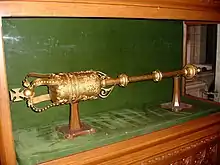
The ceremonial maces in the Canadian Senate and House of Commons embody the authority each chamber derives from the country's sovereign. The current mace in the Commons is the Fourth mace, a replica of the Third one destroyed by fire at the Centre Block in 1916.[15]
A similar practice is employed in each of the provincial and territorial legislatures, with a mace representing the sovereign's authority and power in each of the respective legislatures.
Protocol surrounding the mace
In Canada, each of the legislatures follow a relatively standard protocol in relation to the ceremonial mace; the speaker of the house normally enters following a mace-bearer (normally the sergeant-at-arms), who subsequently sets the mace on the clerks' table to begin the sitting. When the sergeant-at-arms removes the mace from the table, the House has either adjourned, recessed, or been resolved into a committee of the whole. Before the reigning monarch or one of his or her representatives (the governor general or one of the lieutenant governors) may enter a legislative chamber, the mace must be completely hidden from view. This is done by draping the mace in a heavy velvet cloth, a procedure performed by the house pages. During the election of the speaker, the mace is removed from the table to show that the house is not fully constituted until the new speaker takes the chair and the mace is laid on the table.
History of the maces
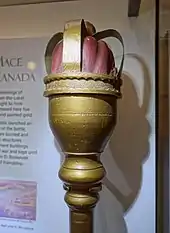
The oldest documented use of a ceremonial mace in a legislature of a British North American colony was at the 1st General Assembly of Nova Scotia, which convened in 1758.[16] The first mace was used by the Chamber of Upper Canada's first Parliament in 1792 at Newark (now Niagara-on-the-Lake) and then moved to York (now Toronto).[17] This first mace was a primitive wooden implement, painted red and gilt and surmounted by a crown of thin brass strips. It was stolen by American troops as a prize of war during the Battle of York of the War of 1812 in 1813. The mace was stored at United States Naval Academy at Annapolis, Maryland and remained in the United States until 1934 when it was returned to Ontario when President Franklin Roosevelt sent an order to Congress to return the mace.[18] It was stored at the Royal Ontario Museum for a time, and is now located in the Main Lobby of the Ontario Legislative Building.[17]
A second mace was introduced in 1813 and used until 1841.[13]
The third mace was not purchased until 1845. In 1849, when the Parliament for the United Province of Canada was sitting in Montreal, it was stolen by a riotous mob, apparently intent upon destroying it in a public demonstration. It was rescued and returned to the Speaker, Sir Allan MacNab, the next day. Later, in 1854, the mace was twice rescued when the Parliament Buildings in Quebec were ravaged by fire. The mace continued to be used by the Union Parliament in Toronto, Quebec City and Ottawa until Confederation in 1867. The new House of Commons of Canada then adopted the mace, where it remained until 1916.[13] The mace of the House of Commons was destroyed when the Centre Block burned down in 1916; all that remained was a fist-sized ball of silver and gold.[13] In the immediate aftermath, the House of Commons used the surviving Senate mace,[13] then the mace of the Ontario provincial legislature for three weeks, after which a wooden mace was crafted and used.[19] In June 1916, the City of London donated a new mace made with the remains of the one destroyed; this mace continues to serve.[13]
Being a symbol of the power and authority of a legislative assembly, a precedent was set in 2002 as to the severity of acts of disrespect toward the mace in Canada and, by proxy, the monarch. After Keith Martin, federal Member of Parliament for Esquimalt—Juan de Fuca, seized the ceremonial mace of the House of Commons from the clerk's table on April 17, 2002, the speaker of that chamber ruled that a prima facie breach of the privileges of the house had occurred,[20] and contempt of the house been committed. Martin was not permitted to resume his seat until he had issued a formal apology from the bar of the house, pursuant to a motion passed in response to the incident.
Parliament of Ontario
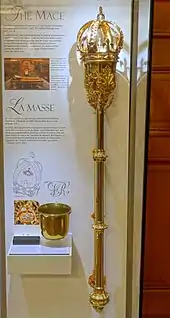
The ceremonial mace of the Parliament of Ontario is the fourth mace to be used in Upper Canada or Ontario. The first, second and third maces used in Ontario, are mentioned above, and were used by the Parliament of Upper Canada and Union Parliament.
After Confederation, the third mace was adopted by the new Parliament of the Dominion of Canada. The current mace used in the Legislative Assembly of Ontario was acquired in 1867. It was provided by Charles E. Zollikofer of Ottawa for $200. The 4-foot (1.2 m) mace is made of copper and richly gilded, a flattened ball at the butt end. Initially, the head of the mace bore the crown of Queen Victoria and in a cup with her monogram, V.R. When she was succeeded by Edward VII in 1901, her crown and cup were removed and a new one bearing Edward's initials on the cup was installed. Eventually, it was replaced with the current cup which is adorned in gleaming brass leaves.[17]
Through some careful detective work on the part of Legislative Assembly staff, the original cup with Queen Victoria's monogram was recently found in the Royal Ontario Museum's collection and returned to the Legislature. It is now on display in the Ontario Legislative Building.[17]
In 2009, two diamonds were installed in the mace. The diamonds were a gift to the people of Ontario from De Beers Canada to mark the opening of the Victor Mine near Attawapiskat First Nation in northern Ontario. Three diamonds were selected from the first run of the mine. Two stones, one rough and one polished, were set in platinum in the crown of the mace while the third stone, also polished, was put on exhibit in the lobby of the Legislative Building as part of a display about the history of the mace.[17]
Parliament of Quebec
The ceremonial mace of the National Assembly was made by Charles O. Zollikoffer in 1867, after the transfer of the maces of the Province of Canada to the new federal parliament in Ottawa. The current mace is of gold with a crown and a cross on its top as well as the letters "ER" (Elizabeth Regina) - added after 1952.
The mace was saved from a fire by Sergeant at Arms Gédéon Larocque in 1883 as well as recovered after being stolen in 1967.[21]
Guyana
The National Assembly, the sole chamber of the Parliament of Guyana, has a ceremonial mace. In March 1991, Isahak Basir, a member of the People's Progressive Party (in opposition at the time), was expelled from parliament for removing the mace from its place on the table, and also for throwing his drinking glass at the Speaker.[22]
Ireland

The silver gilt mace of the old Irish House of Lords is on permanent display at the National Museum, Collins Barracks.
The silver gilt mace of the old Irish House of Commons, which dates to 1765/1766, is now displayed in the old Irish House of Lords Chamber in the old Parliament House which, since 1803, has been Bank of Ireland, College Green, in Dublin.
City councils and universities in Ireland often possess a ceremonial mace.
Myanmar
A ceremonial mace was an essential item of the regalia of Myanmar’s legislative bodies during the British colonization.[23] It kept its significance and symbolism in the early post-independence legislatures. Parliamentary democracy ceased in 1962, but when the regime of General Ne Win revived a one-party unicameral legislature in 1974, the mace-bearing ceremonial was abandoned. It was re-introduced in the new parliament, or Pyidaungsu Hluttaw, convened under the 2008 National Constitution.
Philippines
The House of Representatives and the Senate of the Philippines each have a respective mace. The maces are almost identical.[24][25]
The mace of the House of Representatives serves as a symbol of authority and in the custody of the Sergeant-at-Arms. It serves as a guarantee for the Sergeant-at-Arms in enforcing peace and order in the House upon the Speaker's instruction. Upon every session, the mace is placed at the foot of the Speaker's rostrum. The mace is topped by the official seal of the House of Representatives.[24]
The mace of the Senate also serves as a symbol of authority. It is also displayed at the Senate President's rostrum every session. As with the House of Representatives, the Sergeant-at-Arms also serves as the custodian of the mace. When there is disorderly conduct in the Senate, the Sergeant-at-Arms brings the mace from its pedestal and presents it to the senators causing the disorder, a signal to stop such behavior. The official seal of the Senate also tops the mace.[25]
Sri Lanka
The ceremonial jeweled mace, symbolizing the authority of the Parliament of Sri Lanka, is kept in the custody of the Serjeant-at-Arms. The mace, when kept on its stand in the Chamber, signifies that the House is in session. At the commencement of a Session, the Serjeant-at-Arms bearing the mace accompanies the Speaker when entering and leaving the Chamber. The mace has to be legally brought into the House at the appointed time and removed at the end of the Session. Therefore, unauthorized removal of the mace cannot invalidate proceedings.
United Kingdom
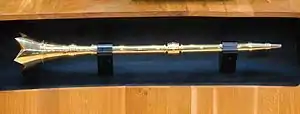
In the United Kingdom there are 13 surviving royal maces in the Crown Jewels, 10 of which are kept in the Jewel House at the Tower of London, while 3 are on permanent loan to the Houses of Parliament. Each mace is about 1.5 m (4.9 ft) long and weighs an average of 10 kg (22 lb).[26] The House of Commons can only operate lawfully when the royal mace – dating from the reign of Charles II– is present at the table. Two other maces dating from the reigns of Charles II and William III are used by the House of Lords: One is placed on the Woolsack before the house meets and is absent when a monarch is there in person.[27] Two maces from the Jewel House are carried in the royal procession at State Openings of Parliament and British coronations. The Scottish Parliament and the Senedd Cymru - Welsh Parliament have their own maces, as do local councils, mayors, and some universities.
United States

The civic maces of the 18th century follow the British type, with some modifications in shape and ornamentation, but most (with the exception of Virginia and South Carolina) incorporate republican imagery as opposed to the monarchical imagery of the previous maces, although arguably imperial Roman imagery is what most influenced their form. Examples of English silver maces in North America include one dating to 1753 at Norfolk, Virginia, and the mace of the state of South Carolina, dating to 1756. The Maryland House of Delegates also has a very old ceremonial mace, although it is the plainest of all, having no ornamentation save some carved vegetation designs at its head (in addition, there are two maces in Jamaica, made in 1753 and 1787; one belonging to the colony of Grenada, made in 1791, and the Speaker's Mace at Barbados, dating from 1812).
The current Mace of the United States House of Representatives has been in use since December 1, 1842. It was created by William Adams at a cost of $400 to replace the first mace, which was destroyed on August 24, 1814 when the Capitol was destroyed in the burning of Washington by the British during the War of 1812. A simple wooden mace was used in the interim.
The current mace is nearly four feet tall and is composed of 13 ebony rods tied together with silver strands criss-crossed over the length of the staff. This design shows the staff with the appearance of a bundled fasces, sans ax, symbolizing unity, the rods representing the 13 original States. It is surmounted by a globus, symbolising dominion, and above that the American eagle with outstretched wings.
When the House is in session, the mace stands in a cylindrical pedestal of green marble to the right of the chair of the Speaker of the House. When the House is meeting as the Committee of the Whole, the mace is moved to a pedestal next to the desk of the Sergeant at Arms. Thus Representatives entering the chamber know with a glance whether the House is in session or in committee.
In accordance with the Rules of the House, when a Member becomes unruly the Sergeant at Arms, on order of the Speaker, lifts the mace from its pedestal and presents it before the offenders, thereby restoring order. This occurs very rarely.
Bands

Drum majors carry a mace to convey commands or signals to their band.[28] According to the Royal Scottish Pipe Band Association, "Drum Major’s maces have been in existence since the 17th century".[29]
Churches
Among other maces (more correctly described as staves) in use today are those carried before ecclesiastical dignitaries and clergy in cathedrals and some parish churches. Other churches, particularly churches of the Anglican Communion, a verger ceremoniously precedes processions.
In the Roman Catholic Church maces used to be carried before Popes and Cardinals. They have long since been replaced with processional crosses. [30]
Universities
Ceremonial maces, symbols of the internal authority over members and the independence from external authority, are still used at many educational institutions, particularly universities. The University of St Andrews in Scotland has three maces dating from the 15th century. The university also has four other maces of a more recent origin. These are on permanent display at the Museum of the University of St Andrews. The University of Glasgow has one from the same period, which may be seen in its arms. University of Innsbruck and its sister Medical University are in possession of maces from 1572, 1588 and 1833, which were confiscated by the Habsburgs from the University of Olomouc in the 1850s.[31]
At the University of Oxford there are three dating from the second half of the 16th century and six from 1723 and 1724, while at the University of Cambridge there are three from 1626 and one from 1628. The latter was altered during the Cromwellian Commonwealth and again at the Stuart Restoration. The mace of the general council of the University of Edinburgh has a threesided head: one with the seal of the University; one with the university's coat of arms and the third with Edinburgh's coat of arms of the City of Edinburgh. The wood for the shaft of the mace is from Malabar and was presented by the Secretary of State for India (R. A. Cross) at the First International Forestry Exhibition (1884).[32] The mace of the Open University reflects its modernist outlook, being made from titanium.[33]
In the United States, almost all universities and free-standing colleges have a mace, used almost exclusively at commencement exercises and borne variously by the university or college president, chancellor, rector, provost, the marshal of the faculty, a dean or some other high official. In those universities that have a number of constituent colleges or faculties, each college, faculty or school often has a smaller mace, borne in procession by a dean, faculty member or sometimes a privileged student. In 1970, Cornell professor Morris Bishop was acting as marshal at a graduation ceremony when a radical student attempted to grab the microphone; Bishop fought him off with the mace.[34][35]

In Canada, some universities have a mace that is used as part of the ceremonial process of conferring degrees during convocation and other special events. The mace is carried by a special university official like a beadle.[36]
In South Korea, Pohang University of Science and Technology has a mace as a part of its ceremonial functions.[37]
In the Philippines, the University of Santo Tomas has a pair of twin maces belonging to the Rector Magnificus. These symbolize his spiritual and temporal power as the highest authority of the university. Made of pure silver and measuring 95 centimeters by 15 centimeters in diameter, the maces have existed since the 17th century and have been used in academic processions ever since. Candidates for doctoral degrees were accompanied by the Rector in a parade called Paseo de los Doctores from Intramuros to Santo Domingo Church, where University commencement exercises were held until the 17th century. Today, faculty members hold processions at the opening of each academic year and during solemn investitures in academic gowns, following the style of Spanish academic regalia. The maces, carried by beadles or macebearers, were included in the parade for their academic symbolism.[38]
Other maces
- The mace of the Cork guilds, made by Robert Goble of Cork in 1696 for the associated guilds of which he had been master, is in the Victoria and Albert Museum. The museum also has a large silver mace dating to the middle of the 18th century, with the arms of Pope Benedict XIV. This mace is said to have been used at the coronation of Napoleon as king of Italy at Milan in 1805.
- Judiciary of Hong Kong opens its legal year with a ceremonial mace carried by the mace bearer and used since the early 20th century.[39]
- Hetmans of Ukrainian Cossacks also had a ceremonial mace, called a bulava.
- The drum major at the front of a marching band may use a mace to communicate movement and musical cues.
References
- al-Gailani Werr, Lamia (1988). Studies in the Chronology and Regional Style of Old Babylonian Cylinder Seals III. Isin-Larsa and Old Babylonian Periods (PDF). Malibu: Undena Publications. p. 17-19.
- "Collection Online". The British Museum. Retrieved 11 December 2018.
- "The War-Mace of Byzantium, 9th-15th C. AD". Acta Militaria Mediaevalia VII. Retrieved 11 December 2018.
- Dawson, Timothy (2015). By the Emperor's Hand: Military Dress and Court Regalia in the Later Romano-Byzantine Empire. Barnsley: Frontline Books. p. 107.
- "The Hedon silver". Hedon Town Council. Archived from the original on 2014-08-26. Retrieved 19 April 2012.
- "The Black Rod: History and role". The Senate of Australia. Retrieved 29 February 2008.
- "History and role of the Mace". The Parliament of Australia. Retrieved 10 April 2012.
- "Gift of the current Mace of the House by King George VI". The Parliament of Australia. Retrieved 29 February 2008.
- "THE STONEWALL". The Sydney Morning Herald. 23 May 1914.
- "MACE INCIDENT". The Sydney Morning Herald. 28 May 1914.
- "THE MACE INCIDENT". The West Australian. 29 May 1914.
- "Information on Parliament". Queensland Parliament. Retrieved 12 December 2018.
- McDonough, John (1979). "The History of the Maces of the British and Canadian Parliaments". Canadian Regional Review. Commonwealth Parliamentary Association. 2 (2). Retrieved 2 June 2019.
- "BAHAMAS (GIFT OF A MACE)". parliament.uk. 19 December 1975. Retrieved 2 June 2019.
- The Law Times. 142. Office of The Law Times. 1917. p. 204.
- "The Senate Mace: From historical weapon to symbol of monarchy". sencanada.ca. Senate of Canada. 28 August 2018. Retrieved 28 March 2020.
- "The Mace". speaker.ontla.on.ca. Archived from the original on 2013-12-13. Retrieved 2017-05-16.
- "Franklin D. Roosevelt: Message to Congress Requesting Authority to Return a Mace to Canada". www.presidency.ucsb.edu. Retrieved 2016-09-28.
- O’Brien, Audrey; Bosc, Marc, eds. (2009). "The Physical and Administrative Setting > The Chamber". House of Commons Procedure and Practice (2nd ed.). Ottawa: Queen's Printer for Canada. ISBN 978-2-89635-321-7. Retrieved 2 June 2019.
- Parliament of Canada (22 April 2002). "The Speaker > House of Commons Canada > Speaker's Rulings". Queen's Printer for Canada. Retrieved 12 April 2009.
- "Masse - National Assembly of Québec". www.assnat.qc.ca. Retrieved 2019-12-19.
- Media Centre // Speeches in the National Assembly // Sub-Judice – Parliament of the Co-operative Republic of Guyana. Retrieved 18 December 2014.
- Egreteau, Renaud (2020). "Parliamentary Rituals, Institutional Continuity, and the Reinvention of Political Traditions in Myanmar". The Journal of Legislative Studies. 26 (1): 124–5. doi:10.1080/13572334.2020.1730487. S2CID 213050677.
- "Symbols of Power and Authority". House of the Representatives of the Philippines. Retrieved 28 February 2011.
- "Symbols of Authority". Senate of the Philippines. Retrieved 28 February 2011.
- Kenneth J. Mears; Simon Thurley; Claire Murphy (1994). The Crown Jewels. Historic Royal Palaces Agency. p. 8. ASIN B000HHY1ZQ.
- "Mace (The)". Parliament.uk. Retrieved 7 December 2015.
- The Military Band. Washington, D.C.: United States Army. 1969. pp. 45–46.
- "Drum Major Manual" (PDF). rspba.org. Royal Scottish Pipe Band Association. Retrieved September 3, 2019.
- Herbermann, Charles, ed. (1913). . Catholic Encyclopedia. New York: Robert Appleton Company.
- Fiala, Jiří (12 July 1998). "Původní žezlo rektora olomoucké univerzity [Original mace of Olomouc University's Rector]" (PDF). Žurnál Univerzity Palackého (in Czech). Olomouc: Palacký University of Olomouc. 7 (28). Retrieved 30 December 2012.
- "The General Council of the University of Edinburgh". Archived from the original on 19 June 2013. Retrieved 10 March 2012.
- "The Open University Mace". The Art of Reflection and Refraction. Retrieved 10 March 2012.
- Joel Rudin (26 November 1973). "Morris Bishop Dead at 80". The Cornell Daily Sun. 90 (61).
- Glenn C. Altschuler; Isaac Kramnick (2014). Cornell: A History, 1940–2015. Ithaca, NY: Cornell University Press. p. 110. ISBN 978-0-8014-4425-8.
- "Convocation ceremony". Nipissing University. Archived from the original on 7 March 2013.
- <인터뷰> 김용민 포스텍 신임총장. Yonhap News (in Korean). 2011-09-07.
- "Rector's regalia heighten pomp and pageantry". The Varsitarian. Archived from the original on 2012-08-02. Retrieved 17 August 2012.
- "Ceremonial opening of the legal year" (PDF). Judiciary of Hong Kong. Archived from the original (PDF) on 3 March 2016. Retrieved 2 February 2016.
External links
 Media related to Ceremonial maces at Wikimedia Commons
Media related to Ceremonial maces at Wikimedia Commons- "German horseman's parade mace". Royal Collection Trust. Inventory no. 67259.
- "English mace". Royal Collection Trust. Inventory no. 31784.
- "Indian mace". Royal Collection Trust. Inventory no. 38133.
- "Zambian mace". Royal Collection Trust. Inventory no. 61781.
